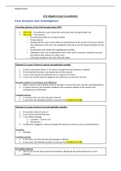Summary
Summary DISTINCTION LEVEL - Civil Litigation BPP - Accelerated LPC - Full Consolidated Exam Notes
- Module
- Civil Litigation
Notes on Civil Litigation for the (Accelerated) LPC at BPP University. These consolidated notes have been optimised for exams in line with SGS learning outcomes. These notes are as concise as they can possibly be to make studying for exams quicker while summarising all SGS course content so you d...
[Show more]



